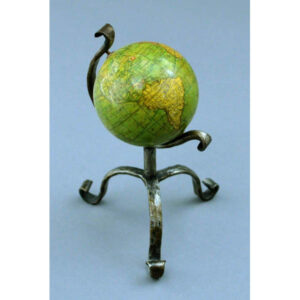Description
Franz Ludwig Güssefeld was a German cartographer, surveyor and engineer known for his highly accurate maps, most of which were published by Homann Heirs in Nuremberg. Indeed, the quality of his work was credited with saving the firm.
Johann Baptist Homann, a former Dominican monk, became a celebrated cartographer of 18th century Nuremberg, Germany, producing maps and celestial charts (generally in atlases), and globes of high quality both in their geographic accuracy and aesthetic appeal. According to map expert R.V. Tooley: “The most important and prolific map-makers in Germany in the 18th century were the Homann family (1702-1813). The founder and principal member was Johann Baptist Homann. He set up his headquarters in Nuremberg and quickly dominated the German market. Nor did he confine his efforts to his homeland, but produced general atlases covering the whole world.”
After settling in Nuremberg in 1688, Johann Baptist Homann was employed as a map engraver before founding his own firm in 1702. Homann’s geographical, celestial, and astronomical maps were published in a variety of atlases throughout the 18th century. Most of his geographical maps first appeared in Neuer Atlas…über die Gantze Welt [New Atlas of the Whole World] (c. 1712-1730, also known in Latin as Atlas Novus) and Grosser Atlas über die Gantze Welt [Grand Atlas of all the World] (c. 1737). His celestial maps, produced in collaboration with Johann Gabriel Doppelmayr, were issued as part of various publications before being published as a collection posthumously by his heirs, most notably as Atlas Coelestis in quo Mundus Spectabilis et in Eodem Stellarum Omnium Phoenomena Notabilia, issued as 30 plates in 1742.
Homann’s geographical maps were frequently republished by the Homann heirs throughout the 18th century, most notably in Atlas Geographicus Maior (c. 1780) and Atlas Homannianus, (Amsterdam, 1731-1796). Homann was initially succeeded by his son, Johann Christoph Homann (1703-1730), then by his friend Johann Michael Franz (1700-1761) and stepsister’s husband Johann Georg Ebersberger (1695-1760). The company continued operations under different names until 1848.
Full publication information: Nürnberg bey den Homannischen Erben Mit Röm Kaiserl allergnädigster Freyheit.
Condition: Generally very good with the usual overall light toning, wear, handling, Vertical center fold as issued.
References:
“Franz Ludwig Güssefeld.” Wikipedia. 23 May 2016. https://en.wikipedia.org/wiki/Franz_Ludwig_G%C3%BCssefeld (25 September 2017).
Tooley, R.V. Maps and Map-Makers. 4th Ed. New York: Bonanza Books, 1970. Tooley p. 99 (re: 1797 map).

![homann-gussefeld-africa Franz Ludwig Güssefeld, Charte von Africa [Map of Africa], Homann Heirs, 1806](https://www.georgeglazer.com/wpmain/wp-content/uploads/2017/09/homann-gussefeld-africa.jpg)




